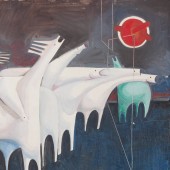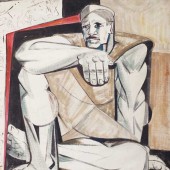Kadhim Hayder
Kadhim Hayder is among the most revered members of Iraq’s modernist movement and was a member of a number of artists groups. Merging his interests in literature, symbolism and daily life, Hayder articulated multiple levels of readings in his painting practice. He studied painting at the Institute of Fine Arts in Baghdad and later attended the Royal College of Art in London to study theatre design and printmaking from 1961 to 1962. After his return to Iraq and infused with a sense of pan-Arab identity, he introduced a new paradigm to his representational style. He focused on the eighth century Battle of Karbala, which resulted in the death of Prophet Muhammad’s grandson Hussein ibn Ali, creating a series of paintings known as Melhamet al-Shahid, or The Martyr’s Epic. An analysis of Hayder’s approach suggests that he re-contextualised the practice of taziya (mourning) through poetry and theatrical re-enactments of the battle. Hayder’s work was exhibited frequently in the 1970s, including at the Musée d’Art Moderne de la Ville de Paris and Baghdad's First Arab Biennial in 1974.
كاظم حيدر هو من أبرز أعضاء حركة الحداثة في العراق وكان عضواً في عدد من الجماعات الفنية. جامعاً اهتمامات بالأدب ونظم الرموز والحياة اليومية، أعرب حيدر عن استقراءات متعددة المستويات في ممارساته الفنية. ودرس الرسم في معهد الفنون الجميلة في بغداد والتحق لاحقاً بالكلية الملكية للفنون في لندن لدراسة التصميم المسرحي وأعمال الحفر بين عامي 1961 و1962. وبعد عودته إلى العراق مفعماً بالانتماء للقومية العربية، أدخل صيغاً جديدة في أسلوبه التصويري. كما ركز على معركة كربلاء التي جرت في القرن الثامن، والتي أدت إلى وفاة حفيد النبي محمد (ص)، الحسين بن علي، فأنتج سلسلة من اللوحات بعنوان "ملحمة الشهيد". واعتبرت بعض التحاليل لنهج حيدر أنه أعاد صياغة تقليد التعزية (الحداد) من خلال الشعر وإعادة تصوير المعركة بأسلوب مسرحي. وتم استعراض أعماله مراراً في سبعينيات القرن الماضي، بما في ذلك متحف مدينة باريس للفن الحديث والبينالي العربي الأول في بغداد.
Related artists by country
- Ahmed Alsoudani
- Ayad Alkadhi
- Dia Azzawi
- Faisal Laibi Sahi
- Halim Al Karim
- Hanaa Malallah
- Hayv Kahraman
- Kareem Risan
- Layla Al Attar
- Nedim Kufi
- Shakir Hassan Al Said
- Suad Al-Attar
- Hafidh Al Droubi
- Ismail Fattah
- Saadi Al Kaabi
- Nouri Al Rawi
- Issam Al Said
- Hassan Massoudy
- Jamil Hamoudi
- Rafa Al Nasiri
- Amer Al Obaidi
- Hani Mazhar
- Hanoos Hanoos
- Maysaloun Faraj
- Sinan Hussein
- Amar Dawood
- Nazar Yahya
- Athier
- Ali Talib
- Mahmoud Obaidi
- Khadeir Al Shakarji
- Ali Al Tajer
- Mahmoud Abboud Fahmy
- Ghassan Ghaib
- Jewad Selim
- Salman Al Basri
- Modhir Ahmed
- Salman Abbas
- Sadik Alfraji
- Tawfik Al Alousi
- Ismael Al Sheikhly
- Sama Al Shaibi
- Adel Abidin
- Afifa Aleiby
- Saadi Al Saffar
- Michael Rakowitz
- Abdul Qadir Al Rassam
- Athar Jaber
- Lorna Selim
- Nabil Safwat
- Nadia Osi
- Faraj Abbo Al Numan
- Khaled Al Jader
- Madiha Umar
- Mahmoud Sabri
- Faik Hassan
- Saleh Al Jumaie
- Atta Sabri
- Jananne Al-Ani
- Abdul Qadir Al Obaidi
- Haidar Al-Mehrabi
- Baghdad Benas
- Naziha Selim
- Rajiha Qudsi
- Ismail Khayat
- Nadira Azzouz
- Widad Orfali
- Zaha Hadid
- Latif Al Ani
- Mahood Ahmed
- Mohammed Ghani Hikmat
- Nuha Radi
- Siham Al Saudi
- Suha Sharif Yousif
- Wasmaa Khalid Chorbachi





